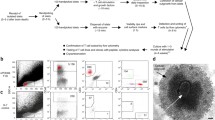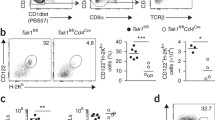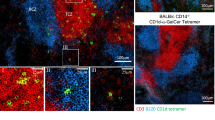Abstract
The RT6 alloantigenic system of the rat has originally been defined on T lymphocytes of the peripheral lymphatic organs and has been considered to be selectively expressed on mature peripheral T cells. Studying NK cells and intestinal intraepithelial lymphocytes (IEL), we have now found that both cell types also express RT6 and that the expression patterns found for IEL and NK cells were markedly different from each other and also from the expression pattern previously described for T cells of the peripheral lymphatic organs. In lymph nodes, spleen, and blood both RT6 and RT6+ T cells have been found and the density of RT6 expression on the positive cells has been shown to vary over a broad range. In contrast more than 98% of intestinal IEL stained for RT6 and the RT6 density was about tenfold higher than on strongly positive T cells of the peripheral lymphatic organs. Furthermore, the same high RT6 density was also found on IEL of athymic nude rats although these cells, to a large extent, lacked other T cell markers. This probably indicates that RT6 expression is an early event in the maturation of intestinal IEL which can occur already before the expression of T cell-specific membrane molecules. The conclusion that the expression of RT6 may be differently regulated in IEL and other T cell populations was further substantiated by the observation that RT6 was also present on IEL of diabetes-prone BB rats which are known to lack RT6 positive T cells in peripheral lymphatic organs. For NK cells still another pattern of RT6 expression was found. Unlike peripheral T cells and IEL, only a small subset of NK cells in blood and spleen expressed RT6. The percentage of RT6 positive cells was increased by in vitro stimulation of isolated NK cells with high concentrations of recombinant rat IL-2 indicating that RT6 expression may be associated with an activated state in NK cells. Taken together, these findings demonstrate that the expression of RT6 is not restricted to T cells and is differently regulated in normal peripheral T cells, intestinal IEL, and NK cells. Since it has recently been demonstrated that the RT6 gene contains two functional promoter regions with major structural disparity it is very likely that the distinct patterns of RT6 expression in different cell types reflect the differential use of the two promoters. The development of this complex control of RT6 expression in evolution may have been driven by a beneficial effect resulting from the use of the RT6 molecular function by several different lymphocyte populations.
Access this chapter
Tax calculation will be finalised at checkout
Purchases are for personal use only
Preview
Unable to display preview. Download preview PDF.
Similar content being viewed by others
References
Lubaroff, D.M., G. Butcher, C. DeWitt, T. Gill III, E. Günther, J. Howard, & K. Wonigeit. 1983. Standardized nomenclature for the rat T-cell alloantigens: Report of the Committee. Transplant. Proc. 15: 1683.
Wonigeit, K. 1979. Definition of lymphocyte antigens in rats: RT-Ly-1, RT-Ly-2, and a new MHC-linked antigen system. Transplant. Proc. 11: 1334–1336.
Wonigeit, K. 1979. Characterization of the RT-Ly-1 and RT-Ly-2 alloantigenic systems by congenic rat strains. Transplant. Proc. 11: 1631–1635.
Butcher, G.W., S. Clarke, & E.M. Tucker. 1979. Close linkage of peripheral T-lymphocyte antigen A (PtaA) to the hemoglobin variant Hbb on linkage group I of the rat. Transplant. Proc. 11: 1629–1630.
Koch, R, H.-G. Thiele, & M. Low. 1986. Release by the rat T cell alloantigen RT6.2 from cell membranes by phosphatidylinositol-speciflc phospholipase C. J. Exp. Med. 164: 1338–1343.
Koch, R, R Haag, A. Kashan, & H.-G. Thiele. 1990. Primary structure of rat 6.2, a non-glycosylated phosphatidylinositol-linked surface marker of postthymic T cells. Proc. Nat. Acad. Sci. U.S.A. 87: 964–967.
Takada, T., K. Iida, & J. Moss. 1994. Expression of NAD glycohydrolase by rat mammary adenocarcinoma cells transformed with rat T cell alloantigen RT6.2. J. Biol. Chem. 269: 9420–9423.
Haag, R, V. Andresen, S. Karsten, R Koch-Nolte, & H.G. Thiele. 1995. Both allelic forms of the rat T cell differentiation marker RT6 display nicotinamide adenine dinucleotide (NAD)-glycohydrolase activity, yet only RT6.2 is capable of automodification upon incubation with NAD. Eur J. Immunol 25: 2355–2361.
Maehama, T., H. Nishina, S. Hoshino, Y. Kanaho, & T. Katada. 1995. NAD+-dependent ADP-ribosylation of T lymphocyte alloantigen RT6.1 reversibly proceeding in intact rat lymphocytes. J. Biol. Chem. 270: 22747–22751
Rigby, M.R., R. Bortell, L.A. Stevens, J. Moss, T. Kanaitsuka, H. Shigeta, J.P. Mordes, D.L. Greiner, & A.A. Rossini. 1996. Rat RT6.2 and mouse RT6 locus 1 are NAD+: Arginine ADP ribosyltransferases with auto-ADPribosylation activity.J Immunol. 156: 4259–4265.
Wang, J., E. Nemoto, A.Y. Kots, H.R. Kaslow, & G. Dennert. 1994. Regulation of cytotoxic T cells by ecto-nicotinamide adenine dinucleotide (NAD) correlates with cell surface GPl-anchored/arginine ADP-ribosyltransferase. J. Immunol. 153: 4048–4058.
Wang, J. E. Nemoto, & G. Dennert. 1996. Regulation of CTL by ecto-nicotinamide adenine dinucleotide (NAD) involves ADP-ribosylation of a p56lck-associated protein. J. Immunol. 156: 2819–2827.
Koch-Nolte, R, R Haag, R. Kastelein, & R Bazan. 1996. Uncovered: the family relationship of a T-cell-membrane protein and bacterial toxins. Immunol. Today 17: 402–405.
Wonigeit, K. Schwinzer, R. 1987. Polyclonal activation of rat T-lymphocytes by RT6 alloantisera. Transplant. Proc. 19: 296–299.
Robinson, P.J. 1991. Phosphatidylinositol membrane anchors and T-cell activation. Immunol. Today 12: 35–41.
Thiele, H.G., R Koch, & A. Kashan. 1987. Postnatal distribution profiles of Thy-1+ and RT6+ cells in peripheral lymph nodes of DA rats. Transplant. Proc. 19: 3157–3160.
Mojcik, C.R, D.L. Greiner, E.S. Medlock, K.L. Komschlies, & I. Goldschneider. 1988. Characterization of RT6 bearing rat-lymphocytes. I. Ontogeny of the RT6 subset. Cell. Immunol. 114: 336–346.
Fangmann, J., R. Schwinzer, & K. Wonigeit. 1991. Unusual phenotype of intestinal intraepithelial lymphocytes in the rat: predominance of T cell receptor a/b+CD2- cells and high expression of RT6 alloantigen. Eur J. Immunol. 21: 753–760.
Fangmann, J., R. Schwinzer, H.-J. Hedrich, & K. Wonigeit. 1993. Demonstration of RT6 expression on a CD3 population of intestinal intraepithelial lymphocytes of athymic nude rats. Transplant. Proc. 25: 2789–2790.
Schwinzer, R., H.-J. Hedrich, & K. Wonigeit. 1989. T cell differentiation in athymic nude rats (rnu/rnu): demonstration of a distorted T cell subset structure by flow cytometry analysis. Eur J. Immunol. 19: 1841–1847.
Fangmann, J., R. Schwinzer, H.-J. Hedrich, I. Klöting, & K. Wonigeit. 1991. Diabetes-prone BB rats express the RT6 alloantigen on intestinal intraepithelial lymphocytes. Eur J. Immunol. 21: 2011–2015.
Kühnlein, P., J.-H. Park, T. Herrmann, A. Elbe, & T. Hünig. 1994. Idenfication and characterization of rat αδ T lymphocytes in peripheral lymphoid organs, small intestine, and skin with a monoclonal antibody to a constant determinant of the γ/δ T cell receptor. J. Immunol. 153: 979–986.
Zolkiewska, A. & J. Moss. 1993. Integrin γ7 as substrate for a glycosylphosphatidylinositol-anchored ADP-ribosyltransferase on the surface of skeletal muscle cells. 1993. J. Biol. Chem. 268: 25273–25276.
Greiner, D.L., E.S. Handler, K. Nakano, J.P. Mordes, & A.A. Rossini. 1986. Absence of the RT6 T cell subset in diabetes-prone BB/W rats. J. Immunol. 136: 148–151.
Groen, H., J.M.M.M. Van der Berk, P. Nieuwenhuis, & J. Kampinga. 1989. Peripheral T cells in diabetes prone (DP) BB rats are CD45R-negative. Thymus 14: 145-.
Burstein, D., J.P. Mordes, D.L. Greiner, D. Stein, N. Nakamura, E.S. Handler, & A.A. Rossini. 1989. Prevention of diabetes in BB/Wor rat by single transfusion of spleen cells. Parameters that affect degree of protection. Diabetes 38: 24–30.
Thiele, H.-G., F. Koch, F. Haag, & W. Wurst. 1989. Evidence for normal thymic export of lymphocytes and an intact RT6a gene in RT6 deficient diabetes prone BB rats. Thymus 14:137–.
Lang, F. & W. Kastern. 1989. The gene for the T lymphocyte alloantigen, RT6, is not linked to either diabetes or lymphopenia and is not defective in the BB rat. Eur. J. Immunol. 19: 1785–1789.
Schwinzer, R., H.J. Hedrich, & K. Wonigeit. 1987. Development of T-like cells in athymic Rowett nude rats (rnu/rnu). Transplant. Proc. 19: 3131–3133.
Hedrich, H.J., K. Wonigeit, & R. Schwinzer. In vivo alloreactivity and xenoreactivity of athymic nude rats. Transplant. Proc. 19: 3199–3202.
Guy-Grand, D., N. Cerf-Bensussan, B. Malissen, M. Malassis-Seris, C. Briottet, P. Vassali. 1991. Two gut intraepithelial CD8+ lymphocyte populations with different T cell receptors: a role for the gut epithelium in Tcell differentiation.J Exp. Med. 173: 471–481.
Lefrancois, L. & S. Olson. 1994. A novel pathway of thymus-directed T lymphocyte maturation. J. Immunol. 153: 987–995.
Vaage, T.J., E. Dissen, A. Ager, I. Roberts, S. Fossum, & B. Rolstad. 1990. T cell receptor-bearing cells among rat intestinal intraepithelial lymphocytes are mainly γ/β+ and are thymus dependent. Eur J. Immunol. 20: 1193–1196.
Chambers, W.H., N.L. Vujanovic, A.B. DeLeo, M.W. Olszowy, R.B. Herbermann, & J.C. Hiserodt. 1989. Monoclonal antibody to a triggering structure expressed on rat natural killer cells and adherent lymphokine-activated killer cells. J. Exp. Med. 169: 1373–1389.
Wonigeit, K. 1996. Expression of RT6 on activated rat T cells. In Koch-Nolte, F., and F. Haag (eds). ADP-Ribosylation in animal tissues: Structure, function, and biology of mono(ADP-Ribosyl)transferases and related enzymes. Plenum Publishing Corporation, New York in press.
Thiele, H.-G., F. Haag, & F. Nolte. 1993. Asymmetric expression of RT6.1 and RT6.2 alloantigens in (RT6a x RT6b)F, rats is due to a pretranslational mechanism. Transplant. Proc. 25: 2786–2788.
Haag, F., F. Nolte, C. Hollmann, & H.-G. Thiele. 1993. Analysis of the gene for the rat T cell alloantigen RT6: evidence for alternative splicing in the 5′ region. Transplant. Proc. 25: 2884–2885.
Haag, F., G. Kuhlenbäumer, F. Koch-Nolte, E. Wingender, & H.-G. Thiele. 1996. Structure of the gene encoding the rat T cell ecto-ADP-ribosyltransferase RT6. J. Immunol. 157: 2022–2030.
Author information
Authors and Affiliations
Editor information
Editors and Affiliations
Rights and permissions
Copyright information
© 1997 Springer Science+Business Media New York
About this chapter
Cite this chapter
Wonigeit, K., Dinkel, A., Fangmann, J., Thude, H. (1997). Expression of The Ectoenzyme RT6 is Not Restricted to Resting Peripheral T Cells and is Differently Regulated in Normal Peripheral T Cells, Intestinal IEL, and NK Cells. In: Haag, F., Koch-Nolte, F. (eds) ADP-Ribosylation in Animal Tissues. Advances in Experimental Medicine and Biology, vol 419. Springer, Boston, MA. https://doi.org/10.1007/978-1-4419-8632-0_28
Download citation
DOI: https://doi.org/10.1007/978-1-4419-8632-0_28
Publisher Name: Springer, Boston, MA
Print ISBN: 978-1-4613-4652-4
Online ISBN: 978-1-4419-8632-0
eBook Packages: Springer Book Archive




